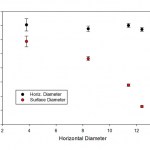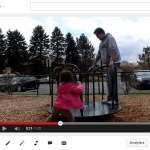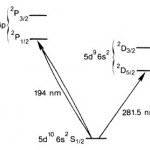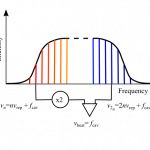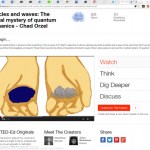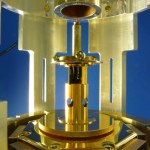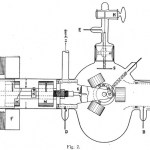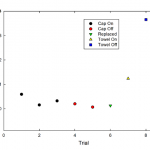Experiment
I tooke a bodkine gh & put it betwixt my eye & [the] bone as neare to [the] backside of my eye as I could: & pressing my eye [with the] end of it (soe as to make [the] curvature a, bcdef in my eye) there appeared severall white darke & coloured circles r, s, t, &c. Which circles were plainest when I continued to rub my eye [with the] point of [the] bodkine, but if I held my eye & [the] bodkin still, though I continued to presse my eye [with] it yet [the] circles would grow faint & often disappeare untill I removed [them] by moving my eye or [the] bodkin.
If [the…
I've decided to do a new round of profiles in the Project for Non-Academic Science (acronym deliberately chosen to coincide with a journal), as a way of getting a little more information out there to students studying in STEM fields who will likely end up with jobs off the "standard" academic science track.
Sixth in this round is an "adult-onset engineer" working at NASA on some cool stuff.
1) What is your non-academic job? I am a thermal engineer at NASA's Jet Propulsion Lab, working in the Cryogenic Systems Engineering group. Our group provides thermal engineering support (both cryogenic…
Back in August, I gave a talk in Stockholm at the Nordita workshop for science writers, about precision measurement searches for physics beyond the Standard Model. There's now video of this online:
The video quality isn't great, but if you'd like a clearer look at the slides, I've posted them on SlideShare. The talk was divided into two parts, though the video is not:
Part 1:
High Precision, Not High Energy: Using Atomic Physics to Look Beyond the Standard Model (Part I) from Chad Orzel
Part 2:
High Precision, Not High Energy: Using Atomic Physics to Look Beyond the Standard Model (…
A couple of times last week, I mentioned on Twitter that I was going to demonstrate relativity with toddler toys and string. This was an inspiration that hit late on Thursday, when I was trying to think of a better way to explain embedding diagrams (the technical term for those stretched-rubber-sheet pictures that everybody uses to illustrate general relativity).
Specifically, I was hearing a lot from students who didn't understand the point of what was supposed to be weird about those. So I was trying to think of how to do a demo, when I realized we could measure the change in geometry that…
I'm teaching relativity in a course with an astronomy prefix, which means I'm obliged to talk about stars and stuff. Yesterday's lecture was about neutron stars, and how their existence was confirmed by the discovery of pulsars (with the story of Jocelyn Bell Burnell included). This requires some discussion of angular momentum to explain how something that big ends up spinning that fast (cribbing a bit from these online notes), so I needed a good demonstration of angular momentum. Which is when I remembered this 2013 post with SteelyKid on the playground, where I estimated the mass of the…
As mentioned last week, I was the on-hand expert for the Secret Science Club's foray into Massachusetts, a screening of the movie Particle Fever held at MASS MoCA. This worked out nicely in a lot of respects-- it gave me an excuse to visit the newly renovated Clark Art Institute in Williamstown and check out the spiffy new library at Williams (where they have my second book on the shelves, but not my first; I may need to send them an author copy in lieu of a check this year...). I also did some random nostalgia things like grabbing dinner at Colonial Pizza (now in a strip mall halfway to…
Over at Backreaction, Bee has a nice piece on our current age of virality. Toward the end, she discusses some of the ways this applies to science, specifically a quote from this Nature article about collaborative efforts to measure "big G", and a story about a Chinese initiative to encourage collaboration. She writes of the latter, "Essentially, it seems, they’re giving out salary increases for scientists to think the same as their colleagues."
And I agree that this can be a problem-- there's a famous paper I can never find looking at the evolution of the accepted value of some physical…
The 2014 Nobel Prize in Physics has been awarded to Isamu Akasaki, Hiroshi Amano and Shuji Nakamura for the development of blue LED's. As always, this is kind of fascinating to watch evolve in the social media sphere, because as a genuinely unexpected big science story, journalists don't have pre-written articles based on an early copy of a embargoed paper. Which means absolutely everybody starts out using almost the exact words of the official Nobel press release, because that fills space while they frantically research the subject. Later in the day, you'll get some different framing, once…
In a weird coincidence, shortly after I wrote a post about "quantum leap" as a metaphor, I was looking up some stuff about John Bell and ran into mentions of a paper he wrote called "Are There Quantum Jumps?" Bell is borrowing a title from Schrödinger, who wrote a pair of articles (really, one article in two pieces) for the British Journal for the Philosophy of Science in 1952 expressing his discontent with the entire idea of "quantum jumps" between states. Bell even opens his paper with a quote from Schrödinger: "If we have to go on with these damned quantum jumps, then I'm sorry that I ever…
On Twitter Sunday morning, the National Society of Black Physicsts account retweeted this:
Using Lasers to Lock Down #Exoplanet Hunting #Space
http://t.co/0TN4DDo7LF
— ✨The Solar System✨ (@The_SolarSystem) September 28, 2014
I recognized the title as a likely reference to the use of optical frequency combs as calibration sources for spectrometry, which is awesome stuff. Unfortunately, the story at that link is less awesome than awful. It goes on at some length about the astronomy, then dispenses with the physics in two short paragraphs of joking references to scare-quoted jargon from the…
My TED@NYC adventure last fall didn't turn into an invite to the big TED meeting, but it did lead to a cool opportunity that is another of the very cool developments I've been teasing for a while now: I've written some scripts for lessons to be posted with TED-Ed. The first of these, on particle-wave duality just went live today.
The content here is very similar to my talk last fall, which is, in turn, very similar to Chapter 8 of Eureka: a historical survey of the development of quantum physics. I did the script for this, which was then turned over to professional animators, who did a great…
I didn't write a summary of the third day of "Quantum Boot Camp" to go with my Day One and Day Two summaries for a simple reason: I would've needed to do that on Saturday, and I spent Saturday in transit back to the US. More than that, though, it was harder to summarize than the other two days, because my talk was the middle of three, and thus I spent most of the first talk fiddling with my slides and fretting, and most of the third fighting off the post-talk adrenaline crash.
Happily, Sedeer at Inspiring Science offers a summary of the first two talks, namely Larus Thorlacius from Nordita…
The second day of the "Quantum Boot Camp" was much lighter on talks. The only speaker was Ray Laflamme from the Institute for Quantum Computing in Waterloo, who gave a nice introduction to quantum technologies. While he did spend a bit of time at the start going through Shor's algorithm for factoring numbers (following up a discussion from Wednesday), he mostly focused on ways to use quantum physics to improve sensors of technological interest.
So, for example, he talked about how efforts to develop techniques for error-correcting codes in liquid state NMR quantum computing led to the…
Since this part of the trip is actually work-like, I might as well dust off the blog and post some actual physics content. Not coincidentally, this also provides a way to put off fretting about my talk tomorrow...
I'm at the Nordita Workshop for Science Writers on quantum theory, which a couple of the attending writers have referred to online as boot camp, though in an affectionate way. The idea is to provide a short crash course on cool quantum physics, so as to give writers a bit more background in subjects they might need to cover.
The first talk was from Rainer Kaltenbaek (whose name I…
I've gotten a few queries about this "Impossible space drive" thing that has space enthusiasts all a-twitter. This supposedly generates thrust through the interaction of an RF cavity with a "quantum vacuum virtual plasma," which is certainly a collection of four words that turn up in physics papers. An experiment at a NASA lab has apparently tested a couple of these gadgets, and claimed to see thrust being produced. Which has a lot of people booking tickets on the Mars mission that this supposedly enables.
Most physicists I know have reacted to this with some linear combination of "heavy sigh…
The latest in a long series of articles making me glad I don't work in psychology was this piece about replication in the Guardian. This spins off some harsh criticism of replication studies and a call for an official policy requiring consultation with the original authors of a study that you're attempting to replicate. The reason given is that psychology is so complicated that there's no way to capture all the relevant details in a published methods section, so failed replications are likely to happen because some crucial detail was omitted in the follow-up study.
Predictably enough, this…
A couple of weeks ago, io9 ran a piece about the old accusations that Robert Millikan manipulated his data for the electron charge with the headlineDid a Case of Scientific Misconduct Win the Nobel Prize for Physics? that got a lot of attention. I wasn't as impressed with this as a lot of other people, mostly because it's mostly just adding a clickbait headline to a story that's been around for decades, and doesn't even really engage with the various responses and defenses of Millikan, including this PDF that offers a (to my mind) fairly convincing argument that most of the argument turns on…
The Schenectady JCC, where SteelyKid and The Pip go to day care, has a playground with a merry-go-round on it. How this hasn't been sued out of existence, I have no idea, but it's a great boon to a physics professor. I've used it before to talk about angular momentum, but this weekend I enlisted SteelyKid's help to make a video illustrating a different sort of physics with the merry-go-round, a camera, and a tennis ball:
As you can see in the video, when the merry-go-round isn't moving, the ball rolls straight, but when it's spinning, the ball follows a curved path. This is a striking…
As I've mentioned here before, I do a lot of work these days in my local Starbucks. This is slightly ironic, as I don't like coffee-- instead, I order tea, which I put in an insulated travel mug. I tend to get the tea, carry the mug back to the table, and let it steep while I boot up the laptop, then pull the teabags out. I get a hot water refill after I finish the first mug, and take it over to campus if I'm going in that day, and those generally carries me through the morning.
At some point, I noticed that when I had the cap on, I tended to end up with a small puddle of liquid next to the…
So, there was this big story in cosmology the other day-- Tom Levenson's write-up is very nice-- which has been hailed as one of the greatest discoveries since the last greatest discovery, blah, blah, blah. And now that a few days have passed, we're starting to see the inevitable backlash, ranging from detailed technical analyses of possible other explanations to more general musings about the nature of peer review. I'm not qualified to evaluate the former, so I'm going to talk a bit about the latter.
The title of that Atlantic post is "'One of the Greatest Discoveries in the History of…

